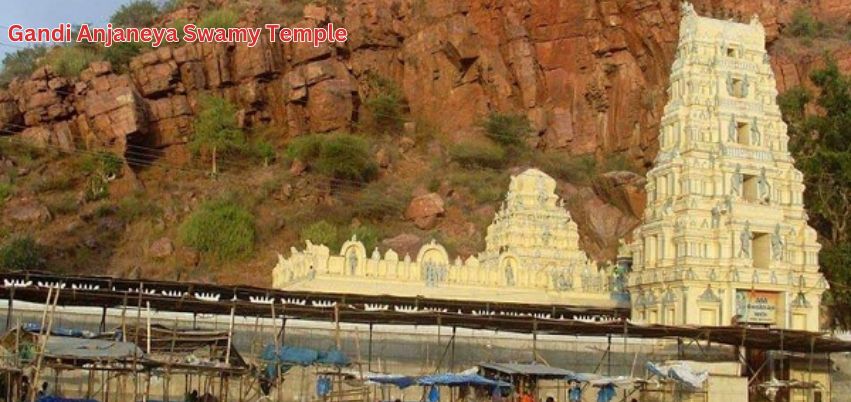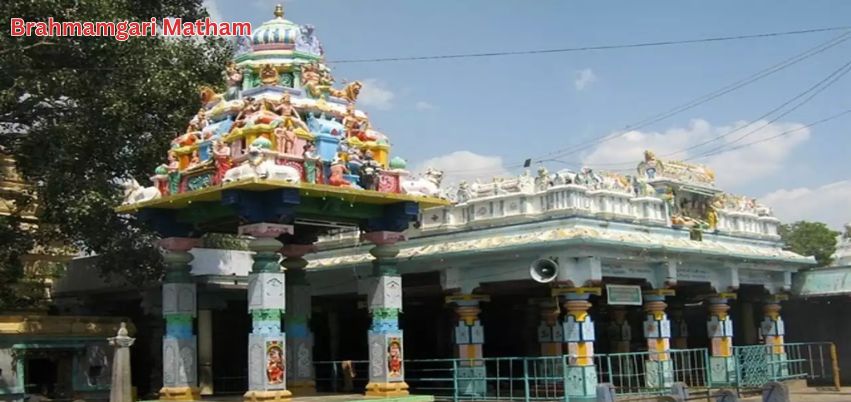Kadapa, also known as Cuddapah, is a city in the Indian state of Andhra Pradesh. It has a rich historical and cultural heritage and is known for its stunning natural landscapes.
Here are the top 7 places to visit in Kadapa:
1. Gandi Anjaneya Swamy Temple

This is one of the most famous temples in Kadapa, dedicated to Lord Hanuman. The temple is located on a hill and offers breathtaking views of the surrounding landscape.
Location: The temple is situated on a hillock in Kadapa, offering visitors a serene and elevated location to worship Lord Hanuman and enjoy breathtaking vistas of the city and the surrounding countryside.
Devotion to Lord Hanuman: The primary deity of the temple is Lord Hanuman, one of the most revered deities in Hinduism. Devotees visit the temple to seek the blessings and protection of Lord Hanuman.
Idol of Lord Hanuman: The temple houses a massive idol of Lord Hanuman. It’s believed to be one of the tallest and most significant Hanuman idols in South India, standing at over 23 feet in height. The idol is depicted in a standing posture.
Spiritual Significance: The temple is a significant pilgrimage site for devotees of Lord Hanuman. Many people visit the temple to offer prayers and seek blessings for various purposes, including strength, courage, and protection from harm.
Panoramic Views: One of the highlights of visiting the temple is the stunning panoramic view it offers. From the hill, you can enjoy beautiful vistas of the city, the surrounding landscapes, and the lush greenery in the area.
Festivals: The temple celebrates various Hindu festivals with great fervor. Hanuman Jayanti, the birthday of Lord Hanuman, is one of the most important celebrations at the temple.
Accessibility: The temple can be reached by climbing a flight of steps that lead to the hilltop. The climb can be a bit steep, but it’s worth it for the temple’s serene ambiance and the views it provides.
2. Sri Venkateswara Wildlife Sanctuary

Located near Kadapa, this sanctuary is home to a variety of wildlife species, including leopards, sloth bears, and many bird species. It’s a great place for nature enthusiasts and wildlife photographers.
Location: The sanctuary is situated in the Eastern Ghats of Andhra Pradesh, covering an area of approximately 353 square kilometers. It is close to the town of Tirupati, making it accessible to tourists and pilgrims visiting the famous Tirumala Temple.
Biodiversity: Sri Venkateswara Wildlife Sanctuary is home to a diverse range of flora and fauna. It hosts various wildlife species, including the Indian giant squirrel, jungle cat, leopard, Indian pangolin, various deer species, and numerous bird species. The sanctuary’s diverse vegetation includes dry deciduous and mixed forests.
Indian Giant Squirrel: The sanctuary is known for its population of the Indian giant squirrel, a rare and unique species that is often seen in the treetops. Observing these squirrels in their natural habitat is a special attraction for wildlife enthusiasts and photographers.
Scenic Beauty: The sanctuary is set against the backdrop of the Eastern Ghats and offers beautiful landscapes with rolling hills, lush greenery, and glistening streams. Visitors can enjoy the picturesque views and serene ambiance.
Trekking and Hiking: The sanctuary offers trekking and hiking opportunities for adventure seekers. Exploring the trails within the sanctuary allows visitors to experience the natural beauty and observe the wildlife.
Best Time to Visit: The ideal time to visit the Sri Venkateswara Wildlife Sanctuary is during the post-monsoon season, from October to February, when the weather is pleasant, and the flora and fauna are at their best.
3. Ameen Peer Dargah

This is a revered Sufi shrine in Kadapa and a place of great spiritual significance. It’s a beautiful structure with a peaceful ambiance.
Location: The Ameen Peer Dargah is located in Kadapa, a city in the southern part of Andhra Pradesh. It is easily accessible to both local devotees and tourists.
Spiritual Significance: The dargah is dedicated to Ameen Peer, who is believed to have been a Sufi saint and a spiritual leader. His teachings and spiritual practices have left a lasting impact on the community, and the dargah is a place where people come to seek blessings, solace, and spiritual guidance.
Architecture: The dargah features beautiful Islamic architecture with domes and minarets. It is adorned with intricate designs and calligraphy. The serene and peaceful ambiance of the dargah makes it a place of meditation and prayer.
Interfaith Harmony: Ameen Peer Dargah is known for its inclusivity and openness to people of all faiths. Devotees from various backgrounds visit the dargah to pay their respects and seek blessings, making it a symbol of religious harmony.
Urs Festival: The annual Urs festival, celebrated at the dargah, is a significant event that draws devotees from different parts of the region. The festival commemorates the death anniversary of Ameen Peer and includes various religious and cultural activities.
Prayers and Offerings: Devotees offer prayers, flowers, and various offerings at the dargah as a mark of their devotion. The dargah’s spiritual leaders or custodians, known as Sajjada Nashin, play an important role in conducting rituals and offering guidance to visitors.
Peaceful Retreat: The dargah and its surroundings provide a peaceful retreat where visitors can find inner peace and reflection. Many people visit the dargah to seek spiritual solace and guidance for their life’s challenges.
4. Ontimitta

This historic village is known for the Sri Kodanda Ramaswamy Temple, which is an ancient temple with intricate architecture. The temple is known for its exquisite sculptures and carvings.
Sri Kodanda Ramaswamy Temple: The primary attraction of Ontimitta is the Sri Kodanda Ramaswamy Temple, dedicated to Lord Rama. The temple is renowned for its exquisite architecture, intricate carvings, and rich historical significance. It is believed to have been constructed during the 16th century by the Vijayanagara Empire.
Architectural Marvel: The Sri Kodanda Ramaswamy Temple is a fine example of Vijayanagara architecture. The temple complex features ornate pillars, beautifully sculpted walls, and a large courtyard. The temple’s main deity is Lord Rama, along with Goddess Sita and Lakshmana.
Rama Navami Festival: The village of Ontimitta comes to life during the Rama Navami festival, which celebrates the birth of Lord Rama. The festival attracts a large number of devotees and tourists who come to witness the grand celebrations and processions at the temple.
Heritage and History: Ontimitta is steeped in history, and the temple’s architecture reflects the rich cultural heritage of the region. Visitors can explore the temple complex and admire the intricate details that have been preserved for centuries.
Accessibility: Ontimitta is easily accessible by road, and it’s situated at a convenient distance from Kadapa city, making it a popular day-trip destination for those interested in history, culture, and architecture.
Religious Significance: The Sri Kodanda Ramaswamy Temple is a place of religious significance, and it holds a special place in the hearts of devotees who come to seek blessings and offer prayers.
Surrounding Landscape: The village and its surroundings offer a glimpse into rural life in Andhra Pradesh, with its scenic countryside, fields, and traditional villages.
5. Brahmamgari Matham

This is a pilgrimage site for devotees of Sri Potuluri Veerabrahmendra Swamy, a renowned saint and prophet. The Matham has a cave temple and is a tranquil place to visit.
Location: Brahmamgari Matham is situated in the village of Kandimallayapalle, which is located near the town of Kadapa (Cuddapah) in Andhra Pradesh.
Sri Potuluri Veerabrahmendra Swamy: The matham is dedicated to Sri Potuluri Veerabrahmendra Swamy, a mystic, scholar, and seer who lived in the 17th century. He is believed to have authored numerous prophecies, known as “Kalagnanam,” in which he predicted events and occurrences in the future.
Spiritual Significance: Devotees from various regions and backgrounds visit Brahmamgari Matham to pay their respects to Sri Veerabrahmendra Swamy and seek spiritual guidance. The site is considered sacred and spiritually significant.
Kalagnanam Predictions: Sri Potuluri Veerabrahmendra Swamy is famous for his predictions about the future, encompassing a wide range of topics, including global events, natural disasters, and the destiny of individuals. Many people believe in the prophetic nature of his writings.
Temple and Ashram: The matham consists of a temple and an ashram dedicated to Sri Veerabrahmendra Swamy. Devotees offer prayers, participate in religious ceremonies, and seek blessings at the temple.
Festivals: The matham celebrates various Hindu festivals with great enthusiasm. Special events and processions are organized during important occasions, attracting a large number of pilgrims and tourists.
Maintaining the Legacy: The caretakers of Brahmamgari Matham continue to preserve the teachings and legacy of Sri Veerabrahmendra Swamy. They also share his prophecies and spiritual insights with visitors.
6. Pushpagiri

This hill station, located about 50 kilometers from Kadapa, offers a cool and serene atmosphere. It’s an excellent place for trekking and enjoying nature.
Location: Pushpagiri is situated approximately 50 kilometers from Kadapa, making it easily accessible for a day trip or a weekend getaway from the city.
Natural Beauty: The region is known for its lush greenery, rolling hills, and dense forests. The hilly terrain is dotted with a variety of flora and fauna, including diverse species of birds and animals.
Trekking: Pushpagiri offers excellent trekking opportunities. The hills and valleys provide a challenging and scenic environment for trekkers. The most popular trekking trail is the one that leads to the Pushpagiri Temple at the hilltop.
Pushpagiri Temple: At the summit of Pushpagiri hill, you’ll find the Pushpagiri Temple, dedicated to Lord Venkateswara. The temple is an important pilgrimage site for locals and visitors.
Adventure Activities: Apart from trekking, you can also indulge in activities like rock climbing, camping, and nature walks in the surrounding areas.
Scenic Views: The hill station offers stunning panoramic views of the surrounding landscape, including lush forests, valleys, and distant hills. The viewpoint is a popular spot for photographers.
Flora and Fauna: The sanctuary is home to various species of wildlife, including leopards, bears, spotted deer, and a wide range of bird species. The lush greenery and varied vegetation add to the sanctuary’s biodiversity.
Best Time to Visit: The ideal time to visit Pushpagiri is during the post-monsoon season (October to February) when the weather is pleasant, and the landscape is at its greenest.
7. Gandikota Fort

Often referred to as the “Grand Canyon of India,” Gandikota Fort is a historical fort located on the banks of the Pennar River. It’s a fantastic place for history lovers and provides stunning views of the river and the rugged terrain.
Location: Gandikota Fort is situated in the Kadapa district of Andhra Pradesh, approximately 15 kilometers from the town of Jammalamadugu. It’s often referred to as the “Hidden Grand Canyon of India” due to its resemblance to the Grand Canyon in the United States.
Historical Significance: The fort dates back to the 13th century and was constructed during the reign of the Pemmasani Nayakas, a local dynasty. It played a significant role in the history of the region and served as a stronghold for various rulers, including the Qutb Shahi dynasty.
Fort Architecture: The fort complex features impressive architectural elements, including a majestic entrance gate and several temples, granaries, and a mosque. The Ranganatha Swamy Temple and Madhavaraya Temple are among the prominent structures within the fort.
Natural Beauty: What sets Gandikota Fort apart is its breathtaking natural surroundings. The fort is perched on the edge of a gorge formed by the Pennar River, and the landscape features deep canyons, towering red sandstone cliffs, and meandering river views.
Canyon Views: The best view of the gorge and the river can be experienced from the vantage points within the fort, especially from the “Grand Canyon Viewpoint.” The striking colors and formations of the rocks make it a photographer’s paradise.
Adventure and Exploration: Beyond its historical and scenic appeal, Gandikota is also a destination for adventure enthusiasts. You can go trekking, rock climbing, and explore the rugged terrain surrounding the fort.
Camping: Camping is another popular activity for visitors who want to spend the night in the midst of this natural wonder. Camping by the canyon allows for a unique and tranquil experience.
Best Time to Visit: The ideal time to visit Gandikota Fort is during the post-monsoon season (October to February) when the weather is pleasant and the landscape is at its greenest.
Read More :
Top 10 Cricket Stadiums Must Visit in India
Mandaragiri Hill: A quick weekend getaway from Bangalore


